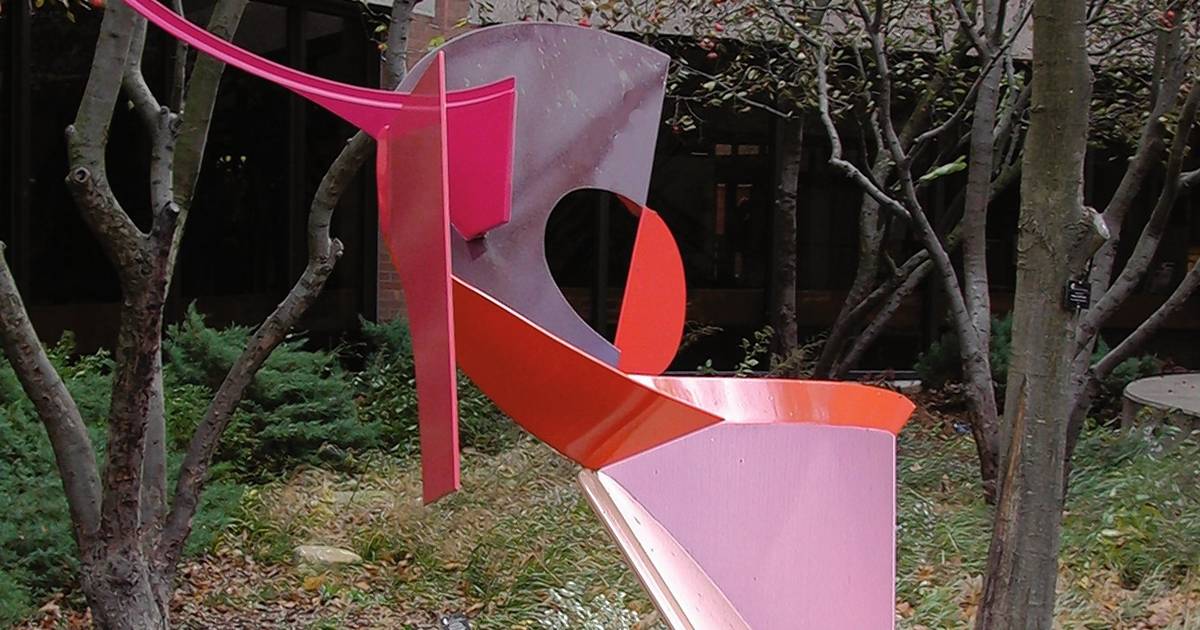Jerry Peart • American B: 1948
Morning Breeze C: 2003 • Aluminum 26" x 24" x 18”
The famed sculptor lay dying in the wreckage of his car beside the highway from Chicago to O’Hare. David Smith dreamed of building sculptures the size of the locomotives he once built for the government. Only weeks before he had mounted the first exhibit of large-scale fabricated and painted sculptures in America. A group of fellow sculptors interested in public sculpture were preparing a major show of Smith-influenced works in Chicago. Now his dream lay shattered among twisted steel and glass.
At the same time, a young sculptor from Arizona arrived in the Windy City. Jerry Peart was as different from David Smith as the dull brown Arizona desert from the northern Illinois forests. Where Smith dreamed of sculptures as big as locomotives, Peart cut his artistic teeth painting small model cars. He used bright colors to contrast with the earth tones surrounding his Winslow, Arizona home.
Arriving in Chicago, Peart fell under the spell of a merry band of Smith followers and began working large. Smith’s welding torch and paint brush had been passed. Soon Peart took Smith’s dreams to a whole new level planting mammoth sculptures in public spaces from Walnut Creek, California to Atlanta, all painted in the same bright colors first used on his model cars. Peart became the Johnny Appleseed of a new movement.
(story continues below break)
INTERESTING STORIES FROM OUR SPONSORS

With three other sculptors, Peart purchased an old electrical substation built for one of Chicago’s last privately-owned train lines. Tearing out the large transformers, they converted the main space into giant studios and the upper areas into apartments for themselves.
Sedgewick Studio became a mainstay in the Chicago art scene as Jerry Peart and his friends churned out their huge painted metal sculptures. The studio still exists today, although Peart has since moved eastward to Virginia.
Carl Sandburg once called Chicago the City of Big Shoulders, and Jerry Peart’s amazing output of behemoth sculptures fit the city’s character perfectly. In the 30 foot tall bays that once powered locomotives, he developed a series of giant sculptures that turned heavy slabs of aluminum into brightly painted whimsical shapes that danced across the landscape as nimbly as Fred Astaire. One found its’ way to Canton, Ohio where it sits in front of the Canton Museum of Art, greeting passers-by like a fresh morning breeze.
Canton Museum of Art Permanent Collection
Gift of Erv and Marie Wilkof, The Hoover Foundation, Stark Community Foundation, Cultural Center for the Arts, National Endowment for the Arts, Margretta Bockius Wilson Fund, City of Canton and James S. Copley Foundation & Philip and Elizabeth Furbay. 2003.3
4 Ways to Sound Smart When Viewing at The Canton Museum of Art
1.
“He first began painting metal in bright colors when he painted model cars as a child. He continued the practice on his sculptures.”
2.
“He became one of the most prominent creators of large scale sculptures for public spaces. Bigger was better.”
3.
“His signature style makes large painted aluminum slabs appear as if they are moving.”
4.
“His first major public installation was painted in a monotone yellow because he could only afford to purchase one color of paint.”
Peart Timeline. Scroll over images to see timeline.



















